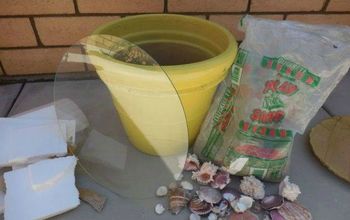How do ya get rid of a patio gutter full of birds?
Related Discussions
GNATS - How to get rid of them?
Somehow my house and garden got tiny gnats that killed my fuchsia plant and fly everywhere. I have tried ALL the Web recommendations - soap and oil dishes, sand in th... See more
Marigolds growing! Should I pinch the buds?
My marigold plants are growing. I heard that pinching the buds until Autumn will allow them to grow without killing the plant. Is this true?
Growing garlic
Growing our first garlic, should we wait until the leaves are drying out before we pick it? Husband picked first one today along with our first potatoes.
How to keep mice out of your garden?
Hi everyone, I have mice in my garden destroying my vegetables and I have also noticed them in the barn and shed. Please can someone tell me how to prevent them from ... See more
What's the best flower/plant to grow in Texas?
I know that opinions vary, but what's your opinion?!I have great luck w Rosemary plants. Green all year long.



Remove their source of food, water and place to sit.
Cheryl gave some good tips. Once the birds are gone, you can add a mesh cover to the gutter to prevent anything else from taking up residence there.
We had a serious bird problem. They were under our gazebo and every time we walked out there, 5-8 birds would fly out of their nests. Once removing the nests, use a Bird B gone gel in all areas where they were coming and going. Wherever they can sit near their nests, put this gel. It is super sticky and gets on their wings which they hate. They will leave!! It was the only thing that worked for us. We tried everything, an owl figure, spikes....nothing worked except this stuff. Good luck!!! https://www.amazon.com/Bird-Gone-MMTBG-Transparent-10-Ounce/dp/B010CSTTS8/ref=sr_1_1_sspa?crid=YATMB80N1SGV&keywords=bird+b+gone&qid=1556122204&s=gateway&sprefix=bird+b+gone%2Caps%2C149&sr=8-1-spons&psc=1&smid=ATZ61JQHZC6XB
Remove their source of food, water and place to sit. Gutter guards,screens/netting,spike strips,rubber snakes. The misleadingly marketed Avitrol brand poison is used to kill birds. Promoted as a “flock frightening agent” or “repellent”, it is in fact a nervous system poison. Birds who consume it suffer convulsions and die. It is not only traumatic for the birds to die this way, but also for any people—especially children—who witness or try to help the dying birds.
Users claim that the distressed behavior of poisoned birds frightens other flock members away. Yet any "frightening” effect of Avitrol on surviving birds is very short-lived, because remaining birds return quickly and reproduce. Taking a small subset out of the population really doesn’t accomplish much other than opening up niche space for other birds to fill. The end result of the use of Avitrol or other lethal bird control methods is an endless cycle of unnecessary killing.NEVER use polybutylene gel. Sticky gel repellents made from polybutene can harm all birds and any animal that comes in contact with it. The HSUS strongly recommends that these dangerous repellents be avoided at all costs. The feathers of any bird who comes into contact with the dense, sticky gel will become damaged, interfering with their ability to fly and to stay water-proofed.
These gel repellents are not selective. Other birds are likely to land on the gel, get stuck, and die a slow death. The polybutene gels are particularly harmful to smaller species.Whilst gel is non-flammable, toxic gasses will form on combustion due to the petroleum content of the product. Repellent gel should always be coated with a sealant compound once installed to ensure that birds do not become ‘glued’ to the substance.Will need to remove dead birds & is not legal to use everywhere, this Gel cannot be removed easily needs scraped and solvents applied.